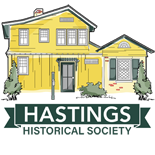
By Keith Doherty

First conceived in the 1830s, Uniontown is the oldest neighborhood in Hastings outside of the original downtown. Developed on land owned by one Sidney Blackwell, it was the village’s first planned residential neighborhood, which had to that point (and for a long time afterward) consisted entirely of farms and estates of wealthy Manhattanites.
Historical Society records suggest that, that from an early date, Uniontown’s population was made up largely of immigrants employed by waterfront industries who came fleeing the often harsh living conditions closer to the river. These mostly Irish homeowners lived in humble structures along the lower portion of High Street and the streets immediately surrounding (Rose, Prince, James, and Green), and further up on Cedar and Hudson Streets.
The need for such a place would have been increasingly profound in mid- to late 19th century Hastings. The immigrant population was growing exponentially at this time, in tandem with the growth of the village’s waterfront industries, to the point that some 70% of the population was foreign born by 1920 (a truly extraordinary statistic for a small Hudson River community in these years). Cramped boarding houses and tenements in what eventually became known as the “foreign section” of town – mainly Southside and Washington Avenues, and Warburton Avenue south of the Ravine – often lacked heat, hot water and private indoor toilets.
A home in Uniontown would have represented the final stage in what is believed to have been a common housing trajectory for immigrant laborers in Hastings. Arriving initially as single men or without their families, foreign workers typically lived first in cheap boarding houses such as Cotlet’s Hotel in the Ravine and similar establishments on lower Washington Avenue.


Then, after they made a little money and were able to send for their families (or married locally and began having children in the US), these working families moved into the tenements until finally they could afford a house in Uniontown or at a few other locations closer to town.
It isn’t clear whether Blackwell and his associates actively courted immigrant families from the start or if they came around to the idea only after immigrants started inquiring (or perhaps because they were having trouble finding other buyers). On an 1851 lots map, the lots are 50’ x 100’ feet in size, but in a subsequent map from 1860 they are only 25’ x 100’, suggesting a new desire to accommodate less affluent buyers.
By 1874 working-class buyers are certainly targeted, when Blackwell’s successors held an auction to sell off the lots remaining at this time. The event is trumpeted on the reverse of an auction map as follows:

The Stonecutters
Many of Blackwell’s very first buyers may have been stonecutters that, after coming to the area initially to help build the Old Croton Aqueduct, stayed in Hastings to work for a large marble quarrying concern just south of Washington Avenue, the town’s first major industry (a site that is currently being redeveloped as a park). This together with a few other quarries in the village that opened in the 19th century – including at least one in Uniontown itself on James Street – employed these men for many years, creating a tradition of stone working in the village.
The legacy of these individuals can be seen all over town in the form of beautifully built masonry walls, typically capped with rows of wedge-shaped “teeth” along the top. Great examples (possibly made from Uniontown granite) survive along High Street. These walls may have been built by Mr. Gorman, an Irish immigrant who lived with his family at 46 High Street, in the early 20th century.

A well-worn path linking the Aqueduct marble quarry and the river to Uniontown was traversed by the stonecutters and later generations of waterfront workers for many years on their way to and from work. It was called “Harvey’s Lane” because it originated as a carriage path in the estate of George Harvey, who owned the marble quarry in the mid-1800s. It was recently rejuvenated and paved by the owners of the Hastings Landing development, through which it now runs.
Owning a home and a plot of land would have been especially significant for men in the stonecutting profession, which was notoriously unstable and required a willingness to pick up and move whenever work dried up. Quitting this itinerant lifestyle must have been a leap of faith and is no doubt a reflection of Hastings’ exceptional mineralogical resources.
Uniontown Cottages
Though they probably represented relative luxury and the realization of the American Dream to their owners, the original Uniontown cottages were humble affairs indeed. Unfortunately, nearly all have been demolished or so enlarged that the original house is near impossible to discern. As a result, few outward signs of the neighborhood’s relatively deep history remain. This process of transforming the old neighborhood has increased dramatically in the last few years, with a number of early structures being replaced by much larger buildings that are well out of character with the original development. This is especially evident along High Street and in the vicinity of the Uniontown Firehouse and the playground. (Note that both of those entities have also been remodeled over the years.)
One early cottage that survived more or less unchanged until its demolition in 2000 stood at 35 High Street. Like many another early Uniontown house, it was a mere 25 by 30 or so square feet in plan, with large front porch and traditional American saltbox extension off the rear. Also common was the simple, 1½ story Cape Cod style elevation and the small “porthole” windows in the upper story under the eaves of the roof. Inside, ceilings were about 7 feet (to conserve heat). Water would probably have come from a well (at least until the water mains were installed under the street around 1930), and heat from a coal stove.

Elsewhere a few structures still stand that, though heavily modified, are not so changed that the original house is invisible. One is the Paquette House at 44 High Street, which dates to the mid-19th century. Despite the addition of a large rear wing and substantial alterations to the upper story, the original house is largely intact at the front.
There is also the mysterious 83 Prince Street, a little brick building known locally as “the Schoolhouse,” which stands very near where Green Street meets Farragut (i.e., Amjo’s). This was the original entrance to the neighborhood, before Farragut was extended and High Street connected to it in the 1930s.

The original structure is quite easy to discern at the front of the house, despite a large addition to the rear from the 1970s. The use of brick and the lack of a large front porch make it unusual for early Uniontown, however, and there is no evidence that it was ever anything other than a private residence.
The Name
Just how and why the neighborhood came to be called Uniontown is an enduring mystery. We don’t know what Blackwell and his associates may have called it originally (if they called it anything), but the moniker “Uniontown” is used as early as 1851 on a map in the Society’s collection.

Many an interesting theory has circulated over the years. The most popular idea – that it came about because early residents were active in labor unions – can’t be true, unfortunately, because the neighborhood was founded some 70 years before any unions were established in Hastings. Somewhat more plausible is the theory that it was named for the Union Army, a regiment of which was briefly stationed in the area during the Civil War. This too is problematic, however, because the name is attested on the 1851 map, well before the war (1861-1865).
The likeliest theory is that it was transplanted from Uniontown, Pennsylvania, because many of the stonecutters supposedly lived and worked there for a time before coming to Hastings to build the aqueduct. “Uniontown” is in any case a fairly common name for municipalities in early 19th century America.
This article is dedicated to the memory of Karolyn Wrightson, a former President of the Hastings Historical Society.
Keith Doherty is a lifelong resident of Hastings and a graduate of Hastings High School. He earned a doctorate in Art History from Boston University in 2009. He currently lives on Cedar Street in Uniontown.














What a beautiful article. Thank you, Keith, and Natalie and the Historical Society. My great aunt and aunt lived on James Street, next to where the quarry might have been, at 105. Quite a small house with a beautiful setting, it looked east . We climbed stone steps with one of those walls you wrote of and pictured to reach the front door. The neighborhoods where people of modest means could live are being transformed into much more grand places!
What a beautiful article. Thank you, Keith, Natalie and the Historical Society. My great aunt and aunt and family lived on James Street, next to where the quarry might have been, at 105. It was a small house with a beautiful setting; it looked east. To reach the front door, we climbed a steep flight of stone steps, with walls like the pictured ones. The Hastings neighborhoods where people of modest means could live are being transformed into much more grand places!
Thank you. I lived in Hastings until 1960 then off to college and Maryland. I always read the historical news letter and appreciate all the hard work you do to keep Hastings a great place to have been raised. Thanks again.
I lived in Hastings from 1945 to 1957. My home was on Mendham Ave near Mount Hope Cemetery. I graduated from Hasting High ii 1950
I now live in Westbury NY.. i have many fond memories of Hastings. My brother lived in Hastings 1945 until his death in 1996.
Thank you for your E Mails.
Max Waage
My grandfather and grandmother built and bought 65 Rose Street in Uniontown, H-O-H, NY. Their names were Francis Newell and Lucy Newell.
My family lived in the little house 83 prince st, back in the early 50s. Have older pics of it also. They messed up building on to it.
Great article, One of the fun memories I have of Uniontown Is taking the bus from Main Street in downtown up to Uniontown as it climbed up high Street ,than on to Yonkers. once coming back from Yonkers my friends and I when (we were young teenagers ) on the ride back, were so scared in a snowstorm that the bus would never make it down that steep high Street hill, so we got off on the corner of Broadway and high Street and walked the rest of the way back down to main st in the snowstorm, we did beat the bus, but it did make it 😊
This was a very interesting and well presented article. I grew up on James St. in the 40’s and 50’s. It was a great place to spend my childhood. Also knew Willy Gorman up the street. He delivered fuel for our furnace. We also could look over the Paquette’s backyard. Great memories! Thanks!
I was born and raised in Uniontown. It has definitely changed a lot since then. I still get very sentimental every time I visit. Going to My old house, all my friends old Houses. (The Paquettes still remain!)
Reminiscing about summers at UT Park, exploring the woods, Riding bikes, The fire siren. It was a great place to grow up.
What a great article! Thanks for the well-researched history. I still expect Ingui’s to be there when I go up High Street and want to stop in there and get a Charleston Chew. God I sound old!
I GREW UP ON FULTON ST. GREAT FOR SLEDDING, NG FOR AUTOS !! TOM HOGAN
Thank you for this informative article with wonderful photographs. I did not know that Uniontown had such an interesting history. I was also intrigued to learn about Harvey’s Lane which belonged to the artist George Harvey, who helped author Washington Irving remodel Sunnyside.
Thanks for the great article. 157 Southside had heat, hot water and toilets. Maybe that part of the street was a bit ‘upscale’ from the tenements :). Such an interesting town that we grew up in. I visit the Historical Society each time I come back to visit. Good stuff.
Hi Keith, nice article! Do you think the stonecutters also built the walls that line Mt. Hope Blvd as it winds down to the parkway?
Hey Rich! I have admired that little stretch many times. Majestic. I think it’s very likely that our guys are responsible (same style, materials, period). If so that is their masterpiece. Much more elaborate than anything else in town, with the internal stairwells, etc.
Great article Keith. I also grew up in Uniontown as my brother and sister did too. It was the backyard playground from 1968 to 1976 for me.
My paperboy route delivering The Herald Statesman encompassed the Fulton, Pine, Cedar and Hudson streets. I especially spent my youth most often ar 44 High St., having shared my days with the Paquette brothers and parents. Can’t forget the important Ingui family corner store where now is a business. The many summers spent at Uniontown park playing ball and the Village Youth Center’s daytime outpost besides Reynolds Field. The firehouse served as the center of many activities, lest the 4:30 pm (quitting) siren. For??? Any suggestions? Quarry shift ended???
Great article Keith, really enjoyed it
Hi,
Lovely article, thank you! My grandparents, then my parents owned what you refer to as the “Dunn House” from around 1920, until my Mother’s estate sold it in 2018 (around 100 years). I never heard of the reference “Dunn House”. Can you please provide (offline) where that name came from? I would prefer this comment not be published, Thank you.
Wonderful articles! My brother suggested we read about the tea house and uniontown article came up next! My great grandparents owned 59 James St. Passed to family until recently. Loved reading about the names I grew up hearing. I had quite a few other relatives in uniontown and my husband grew up next to the aqueduct on Warburton. Many wonderful memories of family and friends.